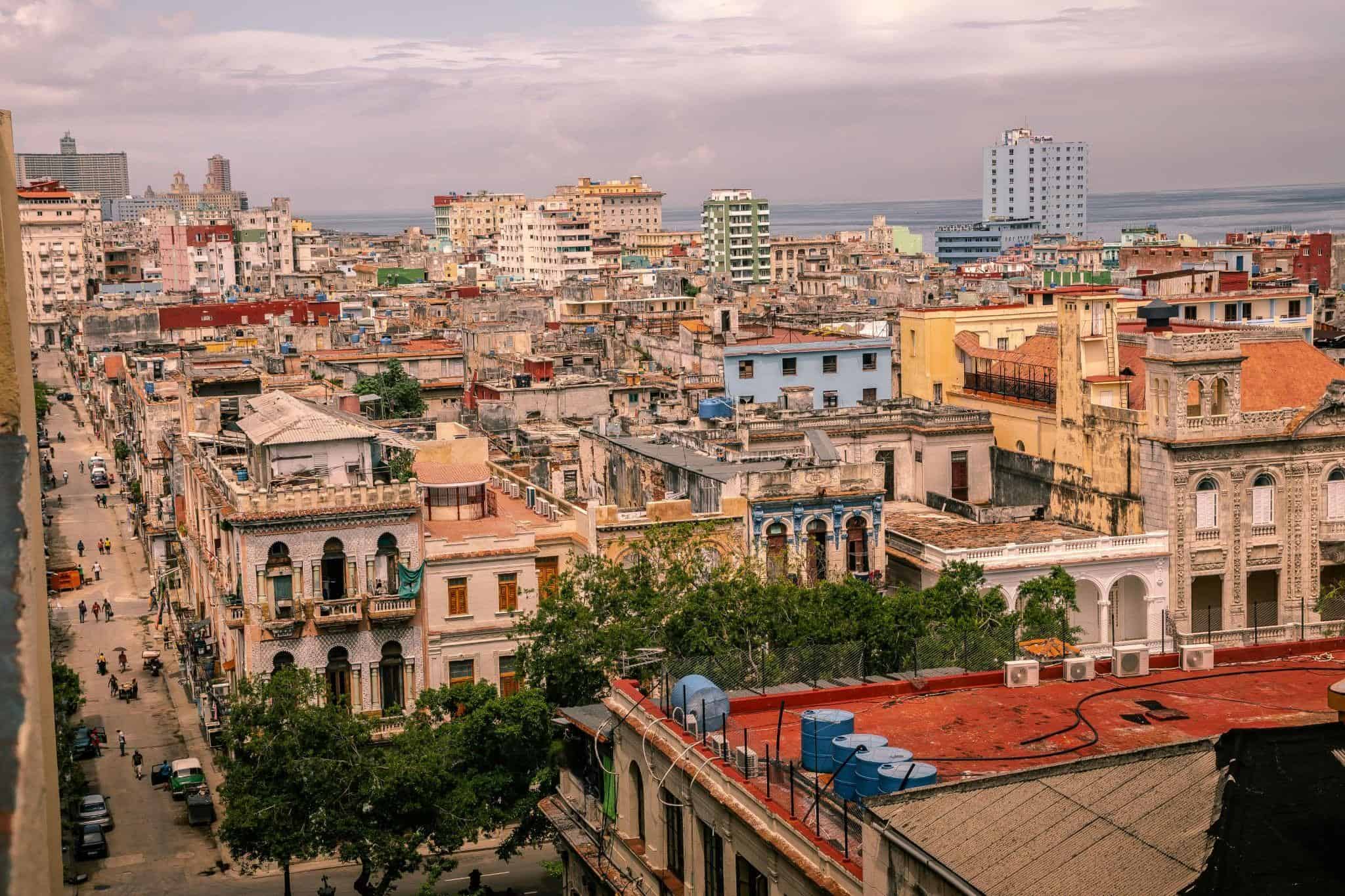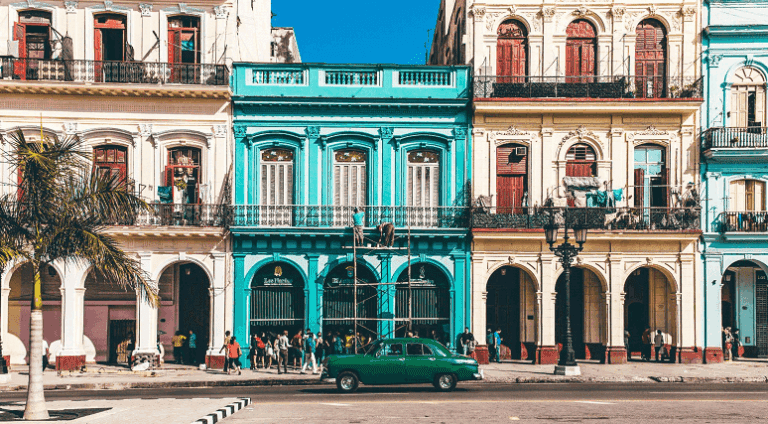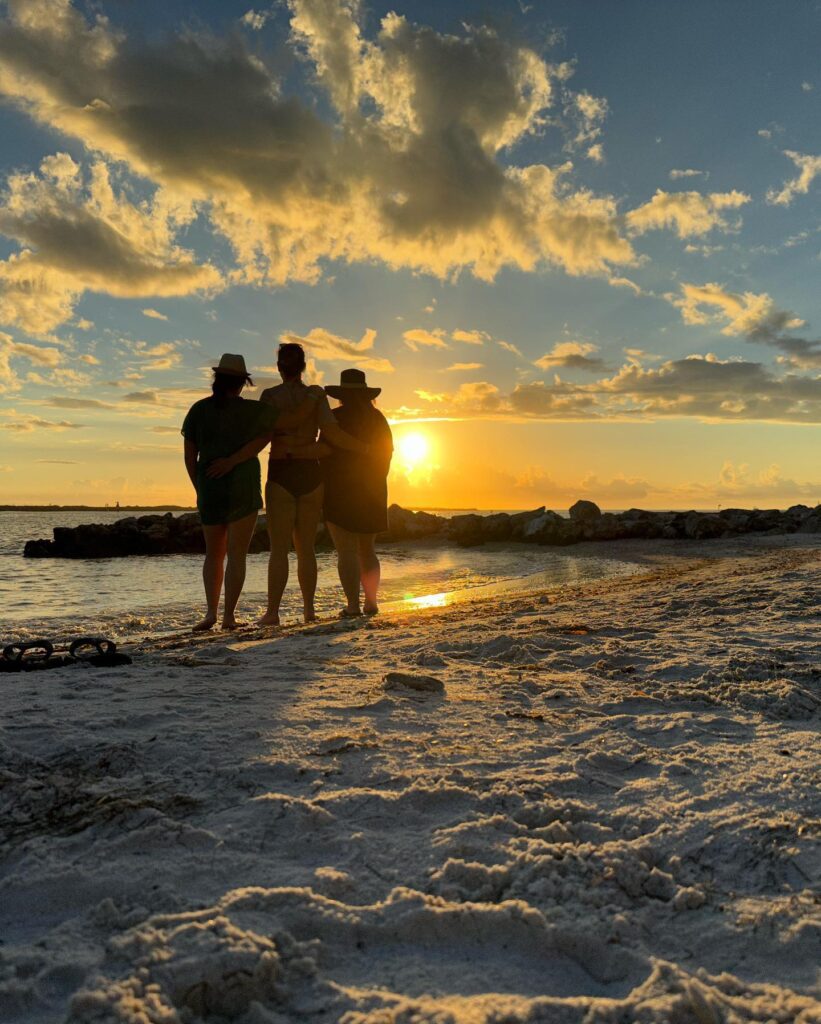Welcome to Havana, where time took a smoke break in 1959 and never came back. This city is a deliciously chaotic mash-up of crumbling colonial buildings, salsa dancing abuelas, and Cadillacs that have seen more action than your dating app. Havana is not just a destination—it’s an experience. And lucky for you, I’ve crammed everything you need to know into one wildly helpful, borderline genius blog post.
Storytime: How I Fell in Love (Literally)
Let me tell you a quick love story. The first time I stepped foot in Havana, I had no idea I was walking straight into a rom-com written by the universe. Somewhere between my first salsa lesson, my third mojito, and a spontaneous ride in a classic car, I met a Cuban tour guide who completely knocked me off my feet (not just during the bachata spins). As of writing this post, I’ve been to Havana eight times. Yep—EIGHT. And every single trip just keeps getting better. So believe me when I say: this guide is backed by lived experience, sunburns, and a whole lotta heart.
Wanna hear more about our epic love story? Check out all the deets here!
Best Time to Visit Havana
Thinking of visiting Havana during hurricane season? Bold move. But if you’re more into sunshine and rum-soaked evenings without the wet chaos, aim for November to April.
When to Avoid:
- May to October: It’s hot, it’s humid, and unless you enjoy spontaneous showers and frizzy hair, maybe hold off.
- July and August: Hello, crowds and sweat. So much sweat.
How to Get to Havana (Visa & Travel Requirements)
Getting to Havana is easy. Getting yourself to leave? Not so much.
Most international travelers arrive via Jose Marti International Airport (HAV) in Havana, but there are also flights to other cities like Varadero and Santiago de Cuba.
For my American amigos:
Yes, you can go to Cuba. No, it’s not illegal. But you do need to fly under one of the 12 approved travel categories (hint: “Support for the Cuban People” is your new BFF).
Visa Requirements:
- S. citizens must travel under one of the 12 categories of authorized travel (like “Support for the Cuban People”). Pure tourism isn’t allowed.
- A Cuban Tourist Card (also called a visa) is required. It must now be purchased online only. You can order it through Cuba Travel Services, and it currently costs $85 USD.
- All travelers must also complete the D’Viajeros online form before arrival. You can fill it out here: https://www.dviajeros.mitrans.gob.cu/inicio.
- Travel insurance is mandatory. Make sure your policy covers you in Cuba. When traveling from the U.S., your boarding pass is proof of insurance coverage, so do not lose this! You can contact your airline to confirm which insurance provider will cover you during your stay (ESICUBA, ASISTUR, etc.).
Check the fine print here: U.S. Cuba Travel Guidelines
Language
Spanish is the official language of Cuba!
Your Duolingo owl will be so proud. Here are a few clutch phrases:
- Hola – Hi
- Por favor – Please
- Gracias – Thank you
- Buenos días / Buenas tardes / Buenas noches – Good morning / Good afternoon / Good evening
- ¿Cómo estás? – How are you?
- Mucho gusto – Nice to meet you
- Me gustaría – I would like
- Yo necesito – I need
- ¿Tiene? – Do you have?
- ¿Dónde está? – Where is?
- ¿Cuánto cuesta? – How much does it cost?
- ¿Qué hora es? – What time is it?
- A la derecha / A la izquierda / Siga derecho – On the right / On the left / Straight ahead
- A una cuadra / A dos, tres, cuatro cuadras– In one block / In two, three, four blocks
- El baño – The bathroom
- Banco / Dinero / Cambio / La cuenta – Bank / Money / Change / The bill
- Yo (no) entiendo – I (don’t) understand
- ¿Habla inglés? – Do you speak English?
- Una cerveza, por favor – One beer, please
- Estoy perdido/a – I’m lost
- Estoy aquí para apoyar al pueblo cubano – “I’m here to support the Cuban people” (repeat like a mantra at customs)
Bonus points for adding some flair with a wink and a mojito.
Tip: Download Google Translate and set it to offline mode so you can use it without internet access.
Wifi & Blackouts in Havana
Wi-Fi and Blackouts in Havana You’re not in Kansas—or Cleveland—anymore, and that means two things: Wi-Fi is elusive, and blackouts are part of the charm.
Blackouts: Rolling blackouts (aka apagones) are a real thing in Havana, especially during the hotter months or times of high energy demand. They can last anywhere from a few minutes to a few hours. Most casas particulares are prepared and have backup lighting—think candles, battery-powered lanterns, or just the vibe of the 1800s. It’s smart to bring a rechargeable mini fan, a battery pack, and a flashlight or headlamp. (Romantic candlelit shower, anyone?)
Wi-Fi Access in Havana: Getting online in Havana is a bit of a treasure hunt—but totally doable. Here’s how:
- Airbnbs: Some have Wi-Fi, though it can be slow or spotty. Ask your host in advance.
- SIM cards: Some Airbnb hosts provide a Cuban SIM card or even a basic Cuban phone—total lifesavers.
- Wi-Fi parks: Public parks with government-run Wi-Fi hotspots. Look for crowds of people huddled around benches with glowing screens. You’ll need to buy a NAUTA Wi-Fi card (sold at ETECSA stores, hotels, or from street resellers).
- Restaurants & bars: Some offer Wi-Fi for customers. Order a mojito, take a seat, and refresh that inbox—very slowly.
- Airport Wi-Fi: Jose Martí Airport offers 30 minutes of free Wi-Fi for arrivals and departures. Use it wisely.
- Mobile hotspots or SIM cards: Rent a portable Wi-Fi device in advance or get a Cuban SIM with data if your phone is unlocked. Just note: both options can be unreliable and pricey.
Apps to Download Before You Go:
- Google Translate (set it to offline mode)
- WhatsApp (the go-to for local communication)
- me (for offline navigation)
Pro tip: Don’t expect to be online 24/7. Embrace the digital detox and enjoy the rhythm of Havana—trust me, it’s way better than your inbox.
Money and Currency
Welcome to the cash-only zone. Here’s what you should know:
- Currency: The official currency is the Cuban Peso (CUP), but U.S. dollars are widely accepted in private businesses.
- Bring CASH. U.S. dollars can be used in many places, but make sure those bills are crisp and new—torn or overly worn cash might be rejected. Treat those Benjamins like royalty.
- Your credit and debit cards are basically useless souvenirs if they’re from a U.S. bank. They won’t work here, so bring enough cash for your whole trip.
- Avoid official exchange spots like CADECA offices, banks, and hotel desks. The rates there are dismal.
- Black market exchange (yes, even on Facebook) offers way better rates. Is it technically illegal? Yes. Is it wildly popular and convenient? Also yes. Use your judgment and never exchange large sums with strangers in sketchy places.
Health and Safety Tips
Cuba is safe, but let’s keep it that way:
- Don’t drink the tap water unless you enjoy international stomach adventures. Stick to bottled or filtered water.
- Bring ALL your meds—plus extras for your travel buddy who “forgot.” Pharmacies aren’t as well-stocked as you’re used to.
- Keep your valuables tucked away—this isn’t a spy thriller, and you don’t want to become the main character.
- Sun protection is non-negotiable: Hat, sunglasses, reef-safe sunscreen. The Caribbean sun does not mess around.
- Insect repellent: Especially during the rainy season—mosquitoes have zero chill.
- Vaccinations: Check with your doctor before your trip. Routine vaccines should be up to date, and Hepatitis A is commonly recommended.
- Enroll in the Smart Traveler Enrollment Program (STEP): It’s free and helps the U.S. embassy contact you in case of emergency. It also makes you feel like a secret agent, so win-win.
Additionally, Havana can be a little scammy. Read here about some common scams and how to avoid them.
Where to Stay in Havana: Neighborhood Guide

Skip the hotel chains. Havana’s charm lives in its casas particulares (aka: Airbnb’s cooler cousin).
- Old Havana: All the charm, all the tourists. This UNESCO World Heritage Site is what most people picture when they think of Havana: cobblestone streets, pastel buildings, and classic cars rolling by like it’s 1955. It’s full of energy, music, and life at all hours of the day. Here, you’re steps away from major attractions like El Capitolio, Plaza Vieja, and La Bodeguita del Medio. Expect crowds, but also expect magic. If you want to be in the heart of the action (and don’t mind a little hustle and bustle), this is your spot.
- Centro Habana: Gritty, real, and surprisingly lovable. Centro is where Havana takes off the makeup and lets you see her soul. It’s raw, colorful, and full of character—with laundry strung across balconies, kids playing baseball in the street, and music blasting from someone’s window. It’s not as polished as Old Havana, but that’s exactly the charm. You’ll find some amazing street food here, super affordable casas particulares, and a more authentic look at daily life in Havana.
- Vedado: Think leafy streets, old-money vibes, and late-night jazz. Vedado is where artists, intellectuals, and expats often hang out. It’s greener and more spacious than other parts of Havana, with tree-lined avenues and 20th-century mansions (some crumbling, some beautifully restored). It’s home to the iconic Hotel Nacional and a solid mix of trendy cafes, music venues, and hidden rooftop bars. Vedado is great if you want a more chill, residential experience with a side of bohemian flair.
- Miramar: Bougie energy with embassy drama. Miramar is Havana’s upscale district, where modern homes meet diplomatic mansions. It’s home to embassies, high-end restaurants, and luxury Airbnbs. It’s quiet, clean, and a bit removed from the center—which makes it perfect if you’re looking for a more relaxed, suburban feel (and don’t mind taking a taxi into the city for sightseeing). Bonus: Lots of spots here have better air conditioning and private pools. Yes, really.
Take a further look at these neighborhoods here.
Getting Around Havana

Your Options:
- Classic Taxis: Worth it for the Instagram alone. Nothing says “I’m in Havana” like cruising past El Capitolio in a hot pink 1957 Chevy.
- Coco Taxis: Adorable yellow helmet-on-wheels. Buckle up (mentally)—these things are basically motorized coconuts with handlebars.
- Bici Taxis: Pedal-powered, breezy, and perfect for short rides through narrow streets. Just be prepared for some friendly haggling and the occasional unsolicited salsa performance.
- Collectivos: These shared taxis are like Cuban Uber Pools, minus the app. They’re cheap, efficient, and a great way to rub elbows with locals—literally, it’s a tight squeeze. Flag one down, name your destination, and hop in. Just have small bills ready and a decent grasp of Spanish.
- The Bus: For the budget traveler with patience (and possibly a folding fan), Havana’s local buses are dirt cheap—but also notoriously crowded and inconsistent. Hop on with a few pesos and a sense of humor. Just don’t expect air conditioning or a clear schedule.
- Walking: The cobblestones weren’t made for stilettos, but they do lead to magic. Bring comfy shoes and a sense of direction—or don’t, and just follow the music.
Pro tip: You can navigate like a pro by downloading offline apps like Maps.me to get around Havana without needing Wi-Fi.
Local Foods to Try
Warning: You might accidentally become a food blogger.
- Ropa Vieja: Shredded beef, not shredded jeans. Slow-cooked in a savory tomato sauce with peppers and onions—it’s basically a hug in a bowl.
- Tostones: Plantains doing the most. Twice-fried, golden, and crispy—perfect with a sprinkle of salt or dipped in garlicky mojo sauce.
- Flan: Like custard, but with Cuban flair. Silky smooth with a caramel crown that makes it feel fancier than it has any right to be.
- Cuban Coffee: Like espresso, but if it joined a punk band. Strong, sweet, and served in tiny cups that pack a wallop. Don’t blink.
- Pastelitos de Guayaba: Flaky pastries stuffed with guava paste and sometimes cheese. Sweet, tropical, and dangerously snackable.
- Congrí: Rice and black beans, but make it iconic. Seasoned to perfection and served alongside just about everything.
- Lechón Asado: Roast pork that’s crispy on the outside, juicy on the inside, and marinated in citrusy goodness—the star of every Cuban celebration.
- Picadillo: Ground beef with potatoes, raisins, olives, and spices. It’s sweet, salty, savory, and confusingly delicious.
Best Things to do in Havana

Here’s what you can’t leave Havana without doing:
- Old Havana (Habana Vieja): The kind of place where your camera roll will run out of space before your legs give out.
- El Malecón: Watch the sunset, flirt with locals, and question all your life decisions.
- Fusterlandia: Imagine if Picasso, Gaudí, and your eccentric aunt exploded all over a neighborhood.
- Revolution Square: Come for the Che mural, stay for the history lesson.
- Classic Car Tour: Cruise the city in a hot pink convertible and feel like you’re in a Cuban Bond film.
Pro Tip: This is my favorite tour in Havana—and the perfect way to get your bearings when you first arrive. You’ll swing by Revolution Square AND Fusterlandia, along with all the major highlights around the city. Be sure to request Emmanuel as your guide—he’s the best.

- Rooftop Drinks: Sip a mojito with a skyline view and pretend you’re in a slow-motion music video.
- Santa María Beach: Thirty minutes from Havana and a thousand miles from your stress.
- Salsa Lesson: Learn to dance with a local—two left feet welcome, but rhythm is highly encouraged.
- Day Trips: Hit Viñales, Las Terrazas, or Matanzas for nature, cigars, or a change of vibe.
Want even more Havana magic? Click here for my full list of 30+ things to do in Havana —including hidden gems, mojito-fueled adventures, and all the must-see spots you didn’t know you needed.
Day Trips and Excursions from Havana
Feeling adventurous? Here’s where to go:
- Viñales: Tobacco fields and countryside that looks straight out of a painting.
- Las Terrazas: Waterfalls, eco vibes, and no cell signal. Bliss.
- Playas del Este: White sand, turquoise water, zero regrets.
- Varadero: Resort town energy with ridiculously blue water and all-inclusive beach naps.
- Cojímar: A sleepy fishing village with Hemingway history and major old-world charm.
Pro Tip: Reach out to this Airbnb host to book the 6-hour vintage car tour, which includes a stop to Ernest Hemingway’s house! Feeling Havana is the perfect way to orient yourself to this magical city!
Book tours with Airbnb, GetYourGuide and Viator, or chat up your casa host—they know a guy who knows a guy.
Nightlife in Havana
Want to dance till your calves cry?
- Fábrica de Arte Cubano: It’s a nightclub! It’s an art museum! It’s everything.
- Casa de la Musica: Salsa or bust.
- El Floridita: Come for the daiquiris, stay for the Hemingway ghosts.
- LM Bar: A stylish rooftop spot perfect for cocktails, live music, and Havana skyline selfies.
- Yellow Submarine Bar: Beatles-themed, blue-lit, and surprisingly Cuban—live rock and roll lives here.
- El Bleco: A local favorite for dancing, drinks, and a no-frills good time that goes late.
For even more sizzling spots after dark, check out my guide Rum, Mojitos, and Music: Best Bars for a Night Out in Havana. It’s packed with my favorite hangouts, from steamy salsa clubs to rooftop bars with mojitos strong enough to make you text your ex. Trust me—you’ll want this list before your first Havana sunset.
Final Thoughts
Havana is messy and magical, slow and sizzling, and guaranteed to leave you a little sunburned and totally in love. If you’re not already packing a suitcase and Googling “best mojitos in Havana,” I don’t know what to tell you.
Subscribe to my blog for more honest (and hilarious) travel tips. And follow me on Instagram [@abobyambergray] to see what it really looks like to salsa at 2am in someone’s backyard.
Have questions? Drop them below. I gotchu.
Link: restaurant guide, First Time in Havana? What to Know Before You Go (2025 Update on What I Wish I Knew).







